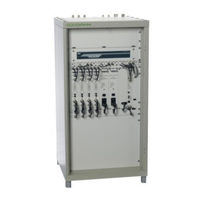DAMM TetraFlex BS421 Manuals
Manuals and User Guides for DAMM TetraFlex BS421. We have 2 DAMM TetraFlex BS421 manuals available for free PDF download: Manual, Installation Manual
DAMM TetraFlex BS421 Manual (408 pages)
Table of Contents
-
-
Revision
16 -
-
Placement21
-
Grounding21
-
Storage Unit23
-
Connections25
-
Switches25
-
Connections27
-
Placement35
-
Grounding35
-
Placement41
-
Grounding42
-
Introduction49
-
-
Introduction55
-
Virus Threat55
-
Standard PC55
-
Bsc56
-
-
-
Dongle Types57
-
-
Bsc72
-
Start Menu73
-
Dispatcher73
-
Log Server74
-
Log Client75
-
Ps42175
-
Tr41275
-
Bs42175
-
-
Static IP86
-
TX Alarm101
-
Diversity102
-
Introduction103
-
TX Power109
-
BS Power Reduced110
-
Log Server
120-
Log API124
-
Log Client129
-
SQL Server130
-
Voice Gateway
131 -
-
API Support144
-
API Installation144
-
API Test Tool149
-
Test Via API OM150
-
Useful Commands151
-
Terminal Gateway
153 -
Tetraom
156-
Commands158
-
Parameters159
-
Tetraom Set up161
-
Tetraom Help164
-
Tetraom Editor166
-
Tetraom Logging167
-
Logging to File167
-
VNC Setup173
-
-
Outdoor/Sb421177
-
Indoor/Bs41X177
-
Group Call182
-
Full Duplex182
-
Half Duplex182
-
Replication182
-
Control Packets182
-
Log Server183
-
Multi Vocoder183
-
Recommendation185
-
Vpn185
-
Ultraedit187
-
Wordpad187
-
Hyperterminal187
-
Putty187
-
3Cdeamon187
-
Tftp32187
-
-
Bsc-Gui191
-
-
Toolbar197
-
NM Menu198
-
File198
-
View202
-
Tools202
-
Help202
-
Selection Icons203
-
Nodes204
-
Status206
-
Map207
-
Figure 3-15: Map207
-
BSC List208
-
Alarms208
-
Status209
-
Config209
-
Subscriber210
-
Sub. Chk211
-
Ip's212
-
Radio Status213
-
Radio Config214
-
Carrier Numbers216
-
Neighbor Cells217
-
Voice GW217
-
SIP Setup218
-
Pd Gw220
-
App GW221
-
Subscribers222
-
Organization223
-
Profile225
-
Group Subscriber238
-
Security Key245
-
Log Servers247
-
Description249
-
Definitions249
-
Backup250
-
Restore250
-
-
Dispatcher
252-
Views254
-
Audio256
-
Language257
-
Calls258
-
Map View259
-
Sds262
-
External Devices262
-
Updates263
-
Direct Call269
-
Call Dialog269
-
Show Favorites272
-
Voice Calls274
-
Volume Control274
-
USB Foot Switch275
-
Dgna281
-
SDS Details286
-
Map288
-
Detach Map288
-
Positioning288
-
Send File293
-
Log Server
296 -
Log Client
299-
Description299
-
Functionality299
-
Statistics View300
-
Node301
-
Radio302
-
Radio Cell Alarm302
-
Voice GW304
-
Voice GW Alarm304
-
Packet Data GW305
-
Application GW305
-
Terminal GW307
-
CDR View309
-
MS RSSI History313
-
Status Views313
-
Status Tab314
-
Common315
-
Subscriber315
-
Radio Status316
-
Radio Config316
-
Voice GW317
-
Packet Data-GW318
-
Application -GW318
-
Terminal-GW319
-
Settings View320
-
Database320
-
Maintenance Now323
-
Nodes328
-
Sound332
-
Logserver Licens334
-
Logserver Config335
-
-
Group Bridge
336 -
-
Introduction354
-
Tma412/Tmd412355
-
RX Antenna356
-
TX Antenna357
-
GPS Antenna358
-
Introduction362
-
Circulator363
-
Cavity Filter365
-
Junction Cables365
-
TX Output Filter366
-
Introduction368
-
-
-
Introduction371
-
Receiver371
-
Transmitter372
-
Dsp374
-
Micro Controller374
-
Introduction379
-
Rectifier379
-
Micro-Controller380
-
-
L Fist of Igures
401
Advertisement
DAMM TetraFlex BS421 Installation Manual (15 pages)
Brand: DAMM
|
Category: Controller
|
Size: 0 MB
Advertisement

